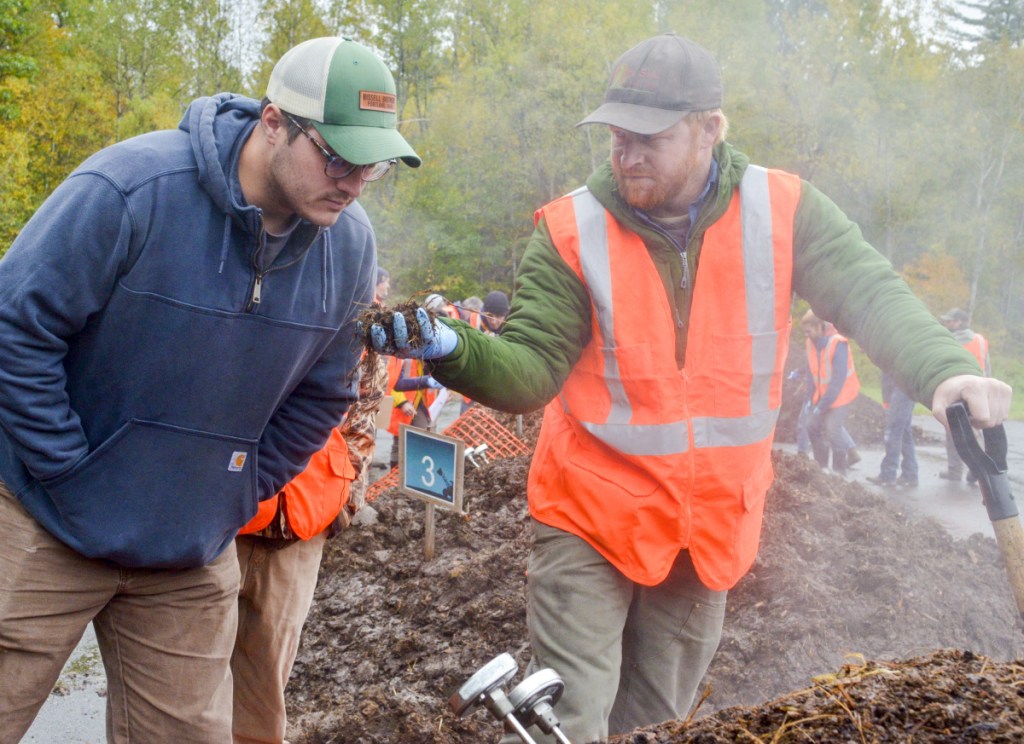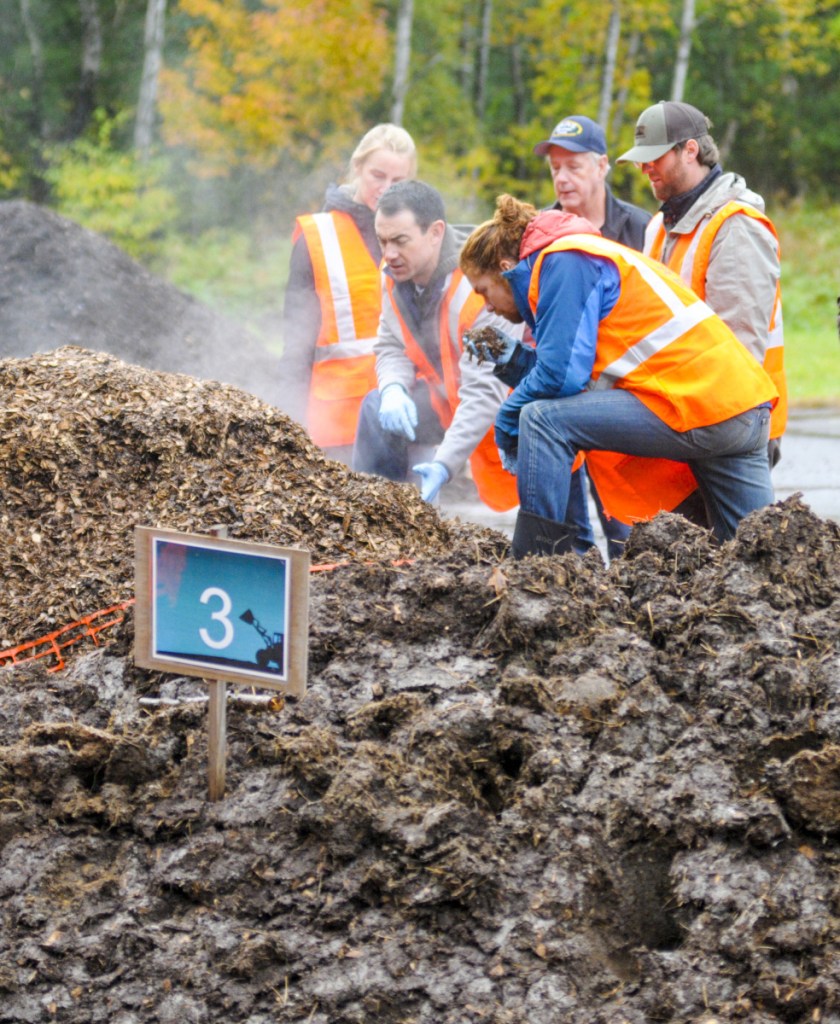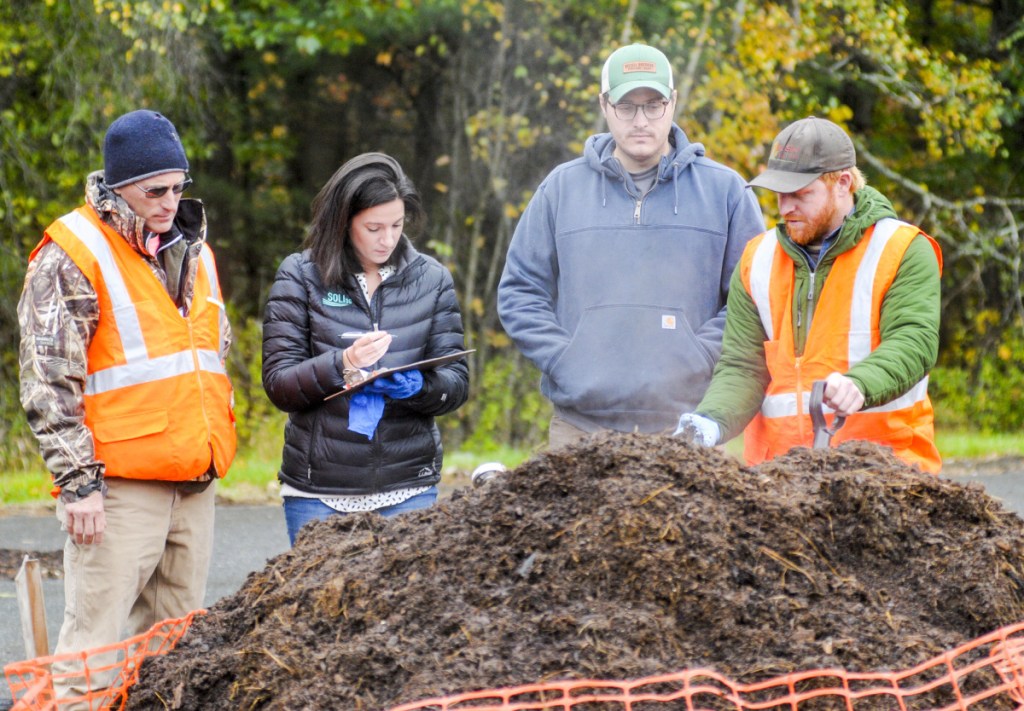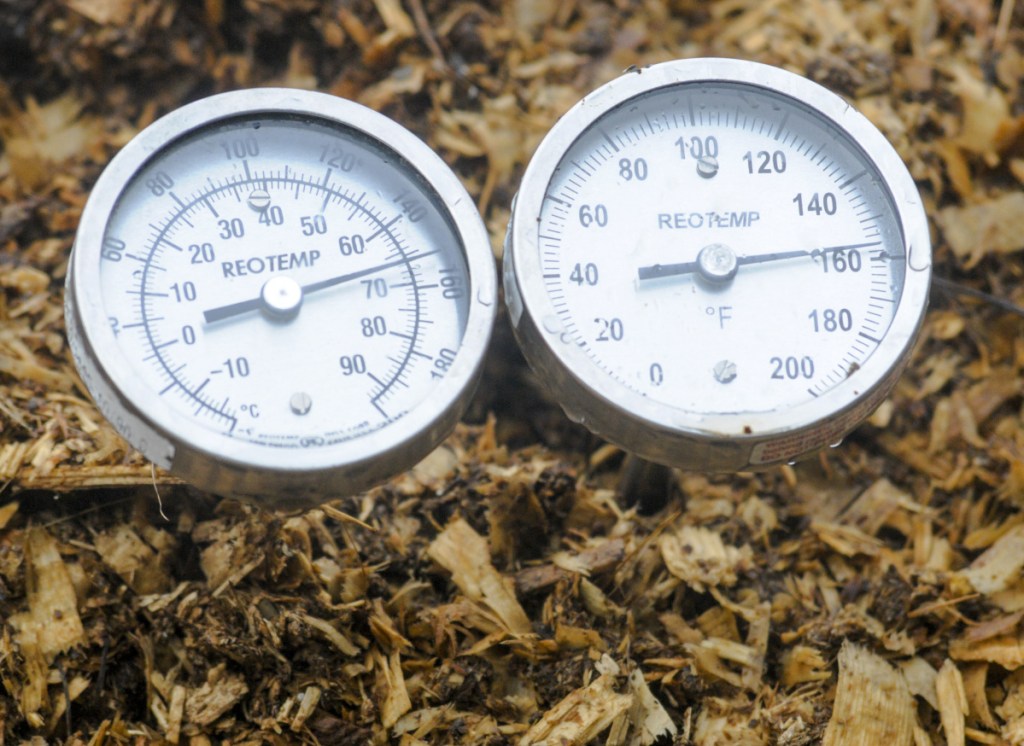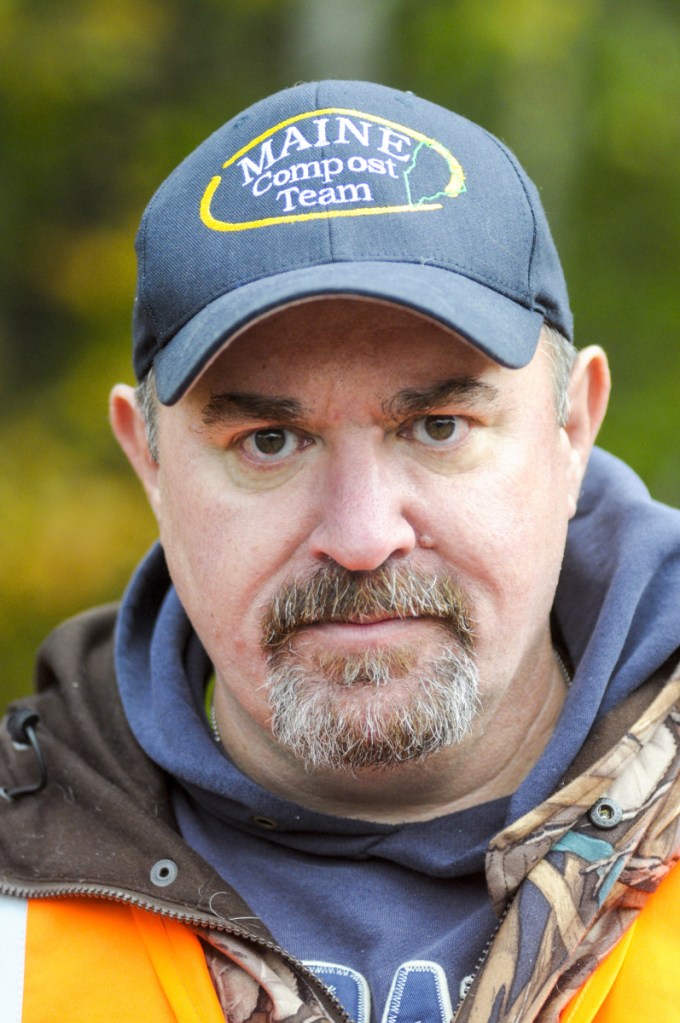MONMOUTH — Students reached into steaming compost piles Wednesday morning, pulling out clumps of material and feeling it for texture and heat and sniffing for odor.
They used short shovels to dig deeper and penetrate the outer layer, which had been soaked by a cold rain. The horse manure and wood shavings were readily visible, as was the smell of decomposing material, and clouds of steam rolled from each of the large piles, the size depending on the heat inside. Two large thermometers poked into each pile, one testing the temperature a foot deep, the other 3 feet deep. This was a hands-on lesson in the science of composting for people involved in medium-scale and large-scale composting operations.
Wednesday morning’s exercise for the 18 students at the Maine Compost School at Highmoor Farm in Monmouth was to identify the piles where the composting process was working the best.
Among the students this week is Ed Holmes, public service manager for the borough of State College, Pennsylvania, which has operated a composting facility that accepts food scraps and organic materials for the past five years.
“Maine is the legendary compost school,” he said. “These guys are recognized as the experts, so I want to learn from them.”
The school, which has operated since 1997, has graduated more than 900 students from 42 countries and almost all the states in the United States.
“There’s a real thirst for compost education given the organic movement,” said Mark A. King, environmental specialist and director of the Maine Compost School. “One of the things that’s really pushed it lately is legalization of marijuana. I’ve been told compost is really great for growing marijuana, and they want to learn how to make it because compost can be pricey.”
He said there is also more interest in growing food locally and buying local.
King said the school got a boost as well when the U.S. Composting Council began to advertise the Maine school nationally. “We always have a waiting list.”
George MacDonald, one of the school’s directors, said each of the compost piles was prepared differently a week ago to illustrate what could go wrong and how to troubleshoot it.
One is too wet; another, too dry. “You need 50 to 65 percent moisture in a pile to have it really compost,” MacDonald said, as he watched the groups of students, each wearing a bright safety vest, circle each of the piles lined up on the large macadam pad.
“You’re looking for a ratio of carbon to nitrogen. You’re looking for 30 parts of carbon to one part nitrogen as kind of the upper range. If you have too much carbon, it’s not going to heat up. If there’s an ammonia smell, there’s a little too much nitrogen. You can also feel the heat, and if you see a gray ash kind of material, that’s a sign of actinomycetes, a microorganism that breaks the organics down.”
“That one’s cooking nicely,” he said, indicating pile 4, which had the most steam rising and temperature readings of 148 degrees Fahrenheit at 1 foot and 118 degrees Fahrenheit at 3 feet.
King said that when the temperature difference is greater than 20 degrees between the 1-foot and 3-foot probes, the pile should be turned.
“You’re redistributing air space and mixing the material. Then it starts all over again. It goes for another week and you flip it again.”
Thursday’s exercise allows the students to build their own compost pile and then do a test to see if it works. He said the object it to teach the students to use their intuition and their senses. “Your senses never let you down — all except for taste. No taste; we discourage that,” King said.
While the piles had been prepared without food scraps, several were ringed at the base with orange snow fencing because they contained apple pomace (the solid remains of apples once they’ve been pressed for juice). MacDonald said the fencing dissuades the wild turkeys from tearing apart the piles to reach the irresistible pomace.
Two of Holmes’ colleagues already are signed up for next year’s course. Two sessions of the Maine Compost School are scheduled for next year: June 17-21, 2019, and Oct. 7-11, 2019. Each session is capped at 20 students, and all are conducted at Highmoor Farm, a Maine Agriculture and Forest Experiment Station.
Holmes said the smell gives a clue as to what’s happening in the compost pile. “I thought I was going to smell manure, because it looks like it’s a predominantly manure pile,” he said. “But when I smelled it, what I got was an acidic smell, so it was kind of a surprise.” A neighboring pile, he noted, had the distinct odor of sauerkraut, and the scent of ammonia emanated from samples of pile 5.
Another student, Albert Diemand, of Keene, New Hampshire, said he and an associate have started a curbside food waste collection program, the Elm City Compost Initiative, there.
“We’re collecting food scraps and organic waste from households and businesses and restaurants in the area, and eventually we want to get to the point where we have our own little facility and compost all of that.” Now it is taken to another facility, which is an added cost. Diemand is the operations and collection manager. “I’m the bucket guy,” he said.
The federal Environmental Protection Agency lists composting on its “Food Recovery Hierarchy,” saying, “Like yard waste, food waste scraps can also be composted. Composting these wastes creates a product that can be used to help improve soils, grow the next generation of crops, and improve water quality.” The agency estimates that “Food composting collection programs served over 3.8 million households in 2015.”
Kelley Mansfield, of Mount Chase in Penobscot County, signed up for the school to learn how to deal with the waste created on her Laughing Beaver Farm.
“I have a small animal farm and we create pig, goat and chicken manure,” she said Wednesday. “I collect food waste to help feed my animals, and I would like to be able to be able to deal with my waste in a way better way and reuse it.”
She said identifying the problems with the compost piles was a particularly valuable exercise. “Being able to know what to look for, what to sniff for, what to squeeze for — to have hands-on experience at this school is just the only way to go: to get the text in the class and then to go out here and physically do it,” she said. “I can bring this home because I did it.”
Donna Pahl Clements, of Riverside, California, was attending the school to assist produce farmers better in southern California and increase produce safety as part of her job as Cornell University’s southwest regional extension associate,
“Composting is a way to kill human pathogens,” she said.
Students can opt to take a technical ability examination at the end of the five-day course, and if they pass it, they receive a certificate of technical ability.
“Most states environmental protection departments require that composting facility operators know what they’re going to be doing, and they accept our certificate of technical ability as qualification for someone who is applying for a permit to do a composting operation,” MacDonald said.
The five-day course costs $525 and includes travel to and from local hotels, breakfast and lunch.
Betty Adams — 621-5631
Twitter: @betadams
Send questions/comments to the editors.


